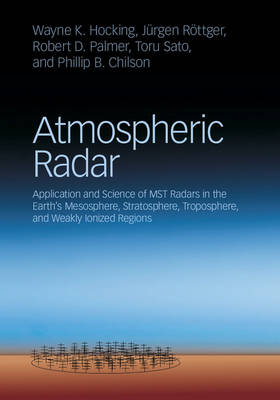
Atmospheric Radar
Cambridge University Press (Verlag)
978-1-107-14746-1 (ISBN)
Richly illustrated, and including both an extensive bibliography and index, this indispensable guide brings together the theory, design, and applications of atmospheric radar. It explains the basic thermodynamics and dynamics of the troposphere, stratosphere, and mesosphere, and discusses the physical and engineering principles behind one of the key tools used to study these regions - MST radars. Key topics covered include antennas, signal propagation, and signal processing techniques. A wide range of practical applications are discussed, including the use of atmospheric radar to study wind profiles, tropospheric temperature, and gravity waves. A detailed overview of radar designs provides a wealth of knowledge and tools, providing readers with a strong basis for building their own instruments. This is an essential resource for graduate students and researchers working in the areas of radar engineering, remote sensing, meteorology, and atmospheric physics, as well as for practitioners in the radar industry.
Wayne K. Hocking is a Professor of Physics at the University of Western Ontario and a Fellow of the Royal Society of Canada and the Australian Institute of Physics. He has built over 40 radars worldwide and has edited multiple special issues of journals. He is the recipient of the Medal for Outstanding Achievement in Industrial/Applied Physics from the Canadian Association of Physicists and the Pawsey Medal from the Australian Academy of Science. He has also received a citation from NASA for his work on the Space Shuttle re-entry environment. Jürgen Röttger is a Fellow of the Royal Astronomical Society and holds the Minerva Medal of the Max Planck Society. He has also held the position of Chair Professor at National Central University. In the 1970s, he was a leading developer of the SOUSY radar. In 1985, he headed atmospheric sciences at the Arecibo Observatory, and from 1986 to 1997, he was the Director of EISCAT, where he was awarded the EISCAT Beynon Medal for his role in the development of the EISCAT Svalbard radar. He also led the design of the Chung-Li MST radar in Taiwan. Robert D. Palmer is the Executive Director of the Advanced Radar Research Center and the Craighead Chair at the School of Meteorology at the University of Oklahoma. He also serves as the University's Associate Vice President for Research. He has published widely in the area of radar sensing of the atmosphere, with an emphasis on imaging problems, waveform design, clutter mitigation, and the application of array/signal processing techniques to observations of both the clear-air environment and severe weather. Professor Palmer is a Fellow of the American Meteorological Society. Toru Sato is a Professor in the Graduate School of Informatics at Kyoto University. He has been engaged in data analysis of the Jicamarca and Arecibo radars, and has contributed to the design and operation of Japanese MST/IS radars, notably the MU radar, Equatorial Atmosphere radar, and PANSY radar. He has published more than 160 journal papers, and in 2015 received the Commendation for Contributors to Promotion of an Oceanic State from the Prime Minister of Japan. Phillip B. Chilson is a Professor in the School of Meteorology at the University of Oklahoma and a member of the University's Advanced Radar Research Center. He has been involved in atmospheric radar research and development for over 25 years and has helped to develop many advanced radar signal processing tools. Professor Chilson has previously held positions at the Max Planck Institute for Astronomy, the Swedish Institute of Space Physics, and the University of Colorado in Boulder.
1. An overview of the atmosphere; 2. The history of radar in atmospheric investigations; 3. Refractive index of the atmosphere and ionosphere; 4. Fundamental concepts of radar remote sensing; 5. Configurations of atmospheric radars - antennas, beam patterns, electronics and calibration; 6. Examples of specific atmospheric radar systems; 7. Derivation of atmospheric parameters; 8. Digital processing of doppler radar signals; 9. Multiple-receiver and multiple-frequency radar techniques; 10. Extended and miscellaneous applications of atmospheric radars; 11. Gravity waves and turbulence; 12. Meteorological phenomena in the lower atmosphere; 13. Concluding remarks.
| Erscheinungsdatum | 16.11.2016 |
|---|---|
| Zusatzinfo | 67 Halftones, color; 24 Halftones, black and white; 65 Line drawings, color; 169 Line drawings, black and white |
| Verlagsort | Cambridge |
| Sprache | englisch |
| Maße | 184 x 255 mm |
| Gewicht | 1820 g |
| Themenwelt | Technik ► Elektrotechnik / Energietechnik |
| Technik ► Nachrichtentechnik | |
| ISBN-10 | 1-107-14746-8 / 1107147468 |
| ISBN-13 | 978-1-107-14746-1 / 9781107147461 |
| Zustand | Neuware |
| Haben Sie eine Frage zum Produkt? |
aus dem Bereich


